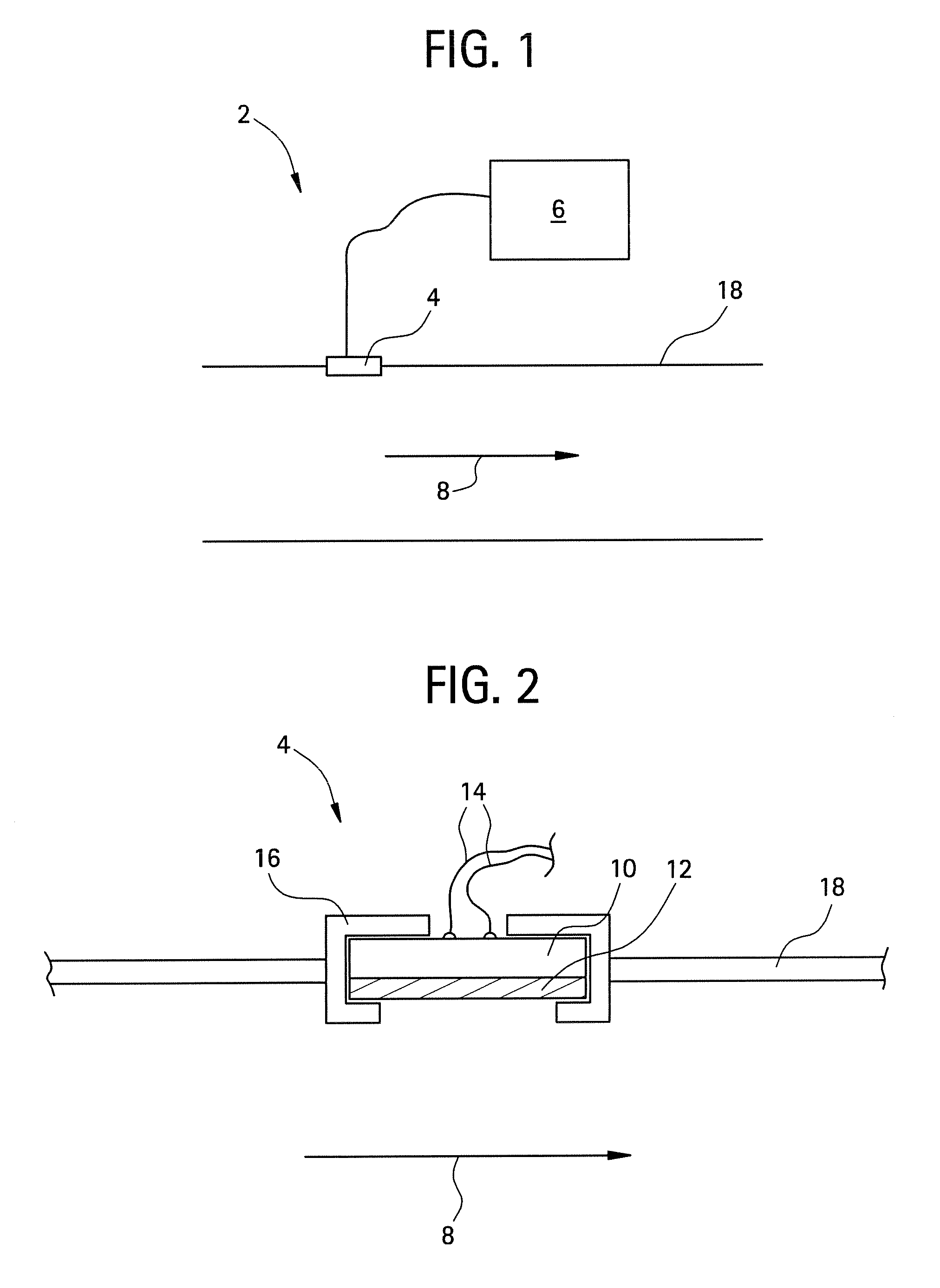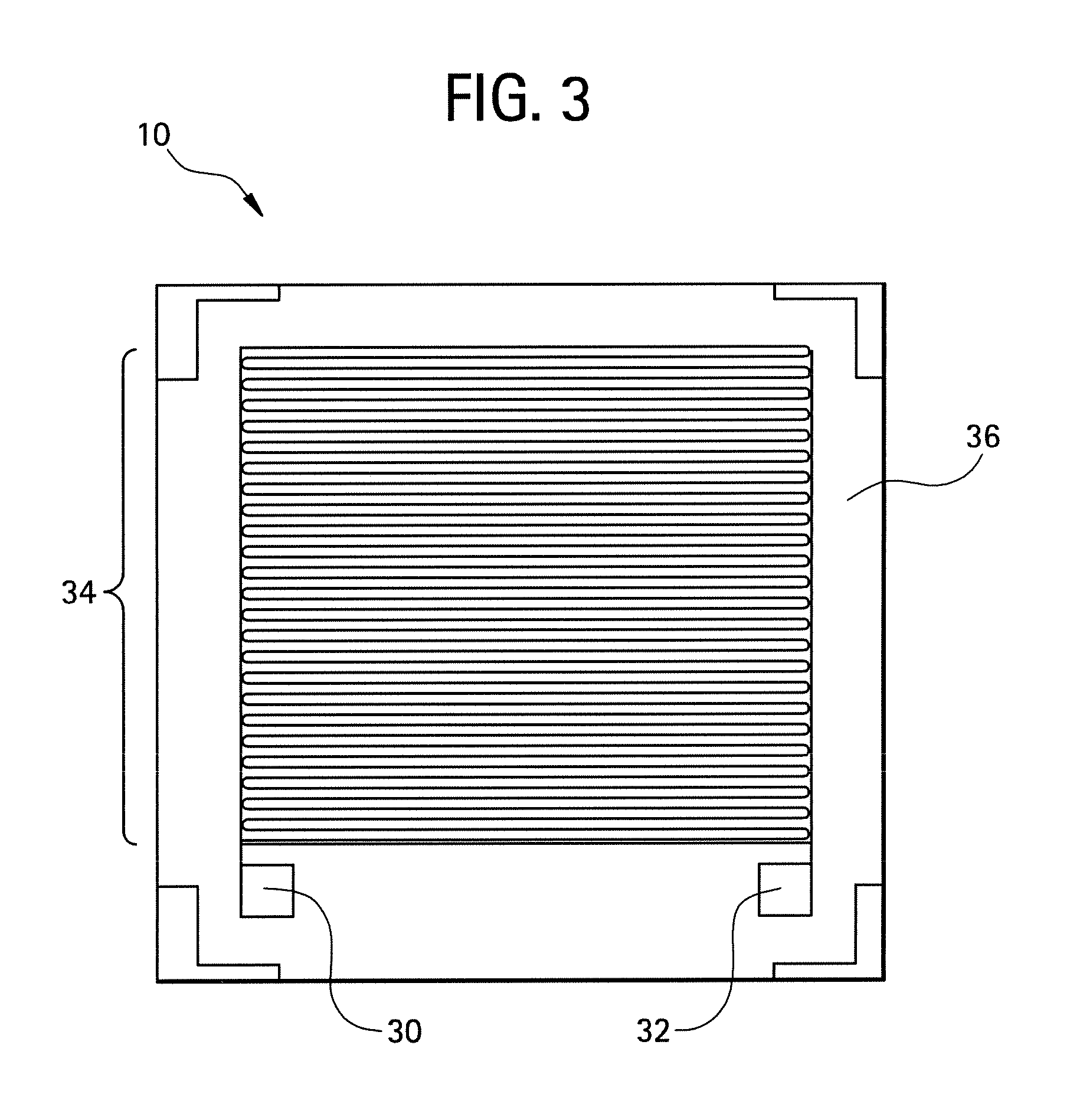Methods for Detecting Contaminants in a Liquid
a technology of liquid contaminants and apparatus, applied in the direction of instruments, nuclear elements, greenhouse gas reduction, etc., can solve the problems of poor selectivity, large sample preparation or limited methods, corrosion and other problems in the fluid handling system of the reactor
- Summary
- Abstract
- Description
- Claims
- Application Information
AI Technical Summary
Benefits of technology
Problems solved by technology
Method used
Image
Examples
experiment 1
[0115]In the first experiment, a sensor 2 was constructed using a radio frequency identification tag as a transducer 10 (operating at nominal frequency of 13.56 MHz) and a polysulfone film 12. The RFID transducer was purchased from Digi-Key, under part number 481-1067-1-ND.
[0116]The sensor was assembled by dissolving polysulfone in dimethyl sulfoxide (DMSO, purchased from Aldrich Chemical Company Inc.) at 37° C. for 24 hours to produce a solution having about 10%-15% solids by volume. A coating was then applied to the RFID transducer and allowed to dry at 37° C. for 24 hours. After the coating was dry, the resulting film 12 had an average thickness of about 50 micrometers.
[0117]The polysulfone-coated sensor 2 was disposed within the conduit of a test apparatus. For comparison, an uncoated transducer 10 was also disposed within the conduit. A data acquisition system (LabVIEW, National Instruments, Inc) was operably connected to the sensor 2 and uncoated transducer 10 such that the Zm...
experiment 2
[0120]In a second experiment, a sensor 2 was constructed using a radio frequency identification tag as a transducer 10 (operating at nominal frequency of 13.56 MHz) and a poly(hydroxyethylmethacrylate) film 12. The sensor was assembled by dissolving poly(hydroxyethylmethacrylate) (Aldrich Chemical Co.) in 1-methoxy-2-propanol (Aldrich) at 20° C. for 24 hours to produce a solution having about 10%-15% solids by volume. A coating was then applied to the RFID transducer and allowed to dry at 20° C. for 24 hours. The resulting film 12 had an average thickness of about 10-50 micrometers.
[0121]The poly(hydroxyethylmethacrylate) coated sensor was disposed in a test apparatus similar to that utilized in Experiment 1 and Experiment 2, however an uncoated transducer was not employed. The apparatus was capable of measuring the Zmax of the poly(hydroxyethylmethacrylate) coated sensor 2 with respect to time.
[0122]The poly(hydroxyethylmethacrylate) coated sensor was subjected to a first aqueous s...
experiment 3
[0124]In a third experiment, a sensor 2 was constructed using a two-electrode gold interdigitated transducer 10 (see FIG. 3) and a polyaniline (PANI) film 12. The aniline monomer was purchased from Aldrich Chemical Company Inc., under part number 242284
[0125]The polymer film 12 was deposited by electropolymerizing the aniline monomer on the surface of the transducer at a concentration of 0.1 M aniline in 1 M H2SO4 under a cycling applied potential between −0.3 V and 1.1 V versus a silver / silver chloride reference at a rate of 50 mV per second. The resulting polyaniline film 12 had an average thickness of about 1 to about 100 micrometers.
[0126]The polyaniline coated sensor 4 was connected to a data acquisition system operated using LabVIEW, National Instruments and subjected to an aqueous solution comprising 40 ppb ZnCl. When the impedance appeared to plateau, water was introduced to purge the ions from the film 12. Thereafter a second aqueous solution comprising 190 ppb ZnCl was pas...
PUM
| Property | Measurement | Unit |
|---|---|---|
| thickness | aaaaa | aaaaa |
| thickness | aaaaa | aaaaa |
| thickness | aaaaa | aaaaa |
Abstract
Description
Claims
Application Information
 Login to View More
Login to View More - R&D
- Intellectual Property
- Life Sciences
- Materials
- Tech Scout
- Unparalleled Data Quality
- Higher Quality Content
- 60% Fewer Hallucinations
Browse by: Latest US Patents, China's latest patents, Technical Efficacy Thesaurus, Application Domain, Technology Topic, Popular Technical Reports.
© 2025 PatSnap. All rights reserved.Legal|Privacy policy|Modern Slavery Act Transparency Statement|Sitemap|About US| Contact US: help@patsnap.com



